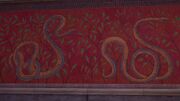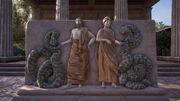
A cobra in Ptolemaic Egypt
Snakes are elongated, legless, carnivorous reptiles found almost worldwide. A few species are venomous, and colloquially, the word "snake" has become synonymous with slyness or deception.
History
Biblical
Moses used a Staff of Eden to create an illusion of it changing into a snake.[1]
6th century BCE
Hermes Trismegistus also held a Staff that was decorated with two intertwined snakes. When he was encountered by Pythagoras and his pupil, Kyros of Zarax, Hermes plunged the staff into the ground and the snakes appeared to speak, informing Pythagoras that he was to be the next possessor of the Staff.[2]
5th century BCE
Snakes featured heavily in the Greek myths, and some signs of the myths still remained in the landscape during the 5th century BCE. The clearest of these were the ruins of the Snake Temple within the Valley of the Snake in Phokis. Named after the skeleton of a gigantic snake wrapped around the stonework, it was believed to have been the Python of legends.[3]
During the Peloponnesian War many snakes inhabited various tombs and ruins all around Greece. Snakes were also a vital part of the practices at the Sanctuary of Asklepios, where they were kept in a tholos and used to heal the sick. They were so important in the proceedings that the Greek god of healing, Asklepios, was usually depicted with a snake-wrapped staff.[3] His daughter, Hygieia, was also said to able to repel harmful snakes, and aid with recovery from their poison.[4]
Snakes were also connected with the mythological Medusa and the Writhing Dread: the hair of said creatures was said to have taken the form of living snakes.[5]
1st century BCE
In order to take out the Templar-influenced pharaoh, Cleopatra, the Egyptian Assassin Amunet used a venomous asp to kill her, according to the legend.[6]
18th century
During the 18th century, particularly the Seven Years' War, French and Indian War, and the American Revolution, many banners were posted all over Boston, New York and River Valley, depicting a snake, and the writing "Join, or Die" by Benjamin Franklin.[7]
Gallery
Appearances
- Assassin's Creed
- Assassin's Creed: Project Legacy
- Assassin's Creed II (mentioned only)
- Assassin's Creed: Origins
- Assassin's Creed: Odyssey










